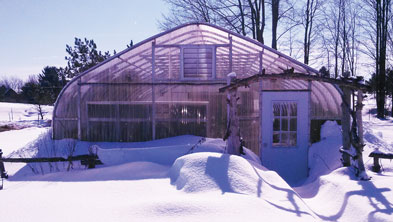10/28/2016
Getting Winter-Ready
Bill Mathis

We all know the importance of adequate ventilation in your greenhouse during the hot summer months to control high temperatures, but winter ventilation is just as important in maintaining a healthy environment for your plants.
Pictured: This Atlas Snow Arch greenhouse has a shutter in the gable used for mechanical ventilation.
Greenhouse ventilation, simply stated, is removing the inside air of the greenhouse and replacing it with fresh outside air. This can be accomplished by natural means, with curtains and vents, or mechanically with fans and shutters. Ventilation systems, regardless of the type, should be sized to meet the demands of each of the growing seasons.
The primary need for winter ventilation in a greenhouse is to control the high humidity and excessive condensation caused by the difference in the inside temperature and the outside temperature.
A heating system is generally needed to create a proper environment for plant growth during the winter months. When the warm humid air that’s been created in the greenhouse comes in contact with the cold surface of the greenhouse frame and covering, condensation occurs. The colder, fresh outside air must be brought in to ventilate the greenhouse and remove the moisture-filled air within the greenhouse. This moisture-filled air, if not removed, will result in increased plant disease, mildew build-up within the greenhouse and accelerated deterioration of the greenhouse structure. Winter ventilation is also beneficial in maintaining a healthy balance of carbon dioxide and oxygen.
It’s important to determine a ventilation rate that will maintain safe humidity levels while keeping heating costs to a minimum. If the air exchange is too high, giving you too much ventilation, you’ll have increased heating costs and possibly a relative humidity that’s too low for healthy plant growth. If the air exchange is too low, you’ll not get enough ventilation, resulting in continued condensation and related problems. A general guideline is two to three air exchanges per hour for winter ventilation, when the inside temperature is being maintained at 60 to 70F (15 to 21C).
The air exchange refers to the volume of air that’s being moved in a given amount of time. In order to determine proper fan size, you must first calculate the total cubic feet of space within the greenhouse. To calculate the cubic feet, multiply the greenhouse width x length x average height. Once the cubic feet have been calculated, size the fan according to its cfm (cubic feet per minute) performance rating to give you the desired air exchange.
Example:
A 30 x 96 gothic greenhouse with an eave height of 10 ft. and a peak height of 18 ft.
30 wide x 96 long x 14 average height = 40,320 cu. ft.
To get an air exchange
of three per hour, multiply the 40,320 x 3 = 120,960
Divide this by 60 minutes per hour
to convert to cubic feet per minute 120,960/60 = 2,016 cfm
So whether through mechanical or natural means, winter ventilation in your greenhouse is necessary during colder months. The information and tips above will allow you to set up your greenhouse for the proper ventilation rate and optimum air exchange, resulting in healthier plants, reduced energy costs, and a longer-lasting structure.
GT
Bill Mathis is Sales Manager for Atlas Greenhouse Manufacturing, Inc. based in Alapaha, Georgia.